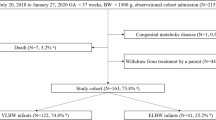Abstract
Introduction
Parenteral nutrition (PN) plays an important role in the nutritional support of very preterm newborns. It has been suggested that a high proportion of PN orders could be standardized. In 2002, we implemented in our unit the preparation of three standardized formulations for PN adapted to the nutritional requirements of premature infants <32 weeks. Following this change of practice, a retrospective observational study was conducted to evaluate the relevance of the implemented standardized PN regime. Twenty premature inborn infants <32 weeks gestation who had received standardized (STD) PN in 2003 were matched for 20 infants who had received individualized (IND) PN in 2001. Adequacy of nutrition was assessed by comparing daily intravenous nutrient intake and biochemical parameters during the first week. Amino-acid intakes on day 3 were higher in the STD group (1.5±0.2 g/kg/d vs. 0.9±0.5, p<0.001), and the calcium phosphate intakes were better balanced. The cumulated intake of amino acids for the first week was greater in the STD group (+20% ; p=0.0003). Biochemical parameters were similar in both groups. Insulin infusions were less frequent in the STD group (p<0.06).
Conclusion
Standardized parenteral formulations provided higher early intakes of amino acid and glucose, a better calcium phosphate ratio, and a greater amount of amino-acid intakes during the first week while maintaining the same biochemical parameters. This strategy forms part of an approach concerning quality control and the respect of good professional practice for the preparation of parenteral nutrition solutions.
Similar content being viewed by others
References
Ahmed M, Irwin S, Tuthill DP (2004) Education and evidence are needed to improve neonatal parenteral nutrition practice. J Parenter Enteral Nutr 28:176–179
Allwood MC, Kearney M (1998) Compatibility and stability of additives in parenteral nutrition admixture. Nutrition 14:697–706
Allwood MC, Hardy G, Sizer T, Driscoll DF (1996) Efect of air and oxygen on parenteral nutrition admixture - an underrated risk? Nutrition 12:222–223
Allwood MC (1997) Microbiological risks in parenteral nutrition compounding. Nutrition 13:60–61
Beecroft C, Martin H, Puntis JW (1999) How often do parenteral nutrition prescriptions for the newborn need to be individualized? Clin Nutr 18:83–85
Cade A, Thorp H, puntis JWL (1997) Does computer improve the nutritional support of the newborn? Clin Nutr 16:1923–1926
Chessex P, Pineault M, Brisson G, Delvin EE, Glorieux FH (1990) Role of the source of phosphate salt in improving the mineral balance of parenterally fed low birth weight infants. J Pediatr 116:765–772
Combeau D, Rey JB, Fontan JE, Nouaille-Degorce B, Brion F (1989) Baxa MicroMacrocompounder for parenteral nutrition solutions in a pediatric hospital. PDA J Pharm Sci Technol 53:226–230
Driscoll DF(2003) Compounding TPN admixtures: then and now. J Parenter Enteral Nutr 27:433–438
Embleton NE, Pang N, Cooke RJ (2001) Postnatal malnutrition and growth retardation: an inevitable consequence of current recommendations in preterm infants? Pediatrics 107:270–273
Escalup L, Crauste-Manciet S, Richard L, Brossard D (2001) Chemical sterilization with peracetic acid: permeation risks into parenteral infusion fluid. PDA J Pharm Sci Technol 55:24–32
Flynn EA, Pearson RE, Barker KN (1997) Observational study of accuracy in compounding i.v. admixtures at five hospitals. Am J Health Syst Pharm 54:904–912
Hartwig SC, Gardner DK (1989) Use of standardized total parenteral nutrient solutions for premature neonates. Am J Hosp Pharm 46:993–995
Kluttgens BU, Sewell GJ, Nunn AJ (2003) Current clinical practice in neonatal and paediatric parenteral nutrition in Europe. Eur J Hosp Pharm 5:5–10
Kuzma-O’Reilly B, Duenas ML, Greecher C, Kimberlin L, Mujsce D, Miller D, Walker DJ (2003) Evaluation, development, and implementation of potentially better practices in neonatal intensive care nutrition. Pediatrics 111:e461–e470
Lunn J, Matthew LA, Weindling AM (1992) Audit: the feasibility of introducing standardised neonatal total parenteral nutrition solutions. Pharm J 249:R41
Maisonneuve N, Raguso CA, Paoloni-Giacobino A, Muhlebach S, Corriol O, Saubion JL, Hecq JD, Bailly A, Berger M, Pichard C (2004) Parenteral nutrition practices in hospital pharmacies in Switzerland, France and Belgium. Nutrition 20:528–535
Morgan C, Keady S, Ozzard A, Chauhan B (2003) A standard aqueous parenteral nutrition formulation for neonatal intensive care. Clin Nutr 22:S70
Morris AM, Schneider PJ, Pedersen CA, Mirtallo JM (2003) National survey of quality assurance activities for pharmacy-compounded sterile preparations. Am J Health Syst Pharm 60:2567–2576
National Advisory Group on Standards and Practice Guidelines for Parenteral Nutrition (1998) Safe practices for parenteral nutrition formulations. J Parenter Enteral Nutr 22:49–66
Pelegano JF, Rowe JC, Carey DE, LaBarre DJ, Raye JR, Edgren KW, Horak E (1989) Simultaneous infusion of calcium and phosphorus in parenteral nutrition for premature infants: use of physiologic calcium/phosphorus ratio. J Pediatr 114:115–119
Pereira-da-Silva L, Nurmamodo A, Amaral JM, Rosa ML, Almeida MC, Ribeiro ML (2003) Compatibility of calcium and phosphate in four parenteral nutrition solutions for preterm neonates. Am J Health Syst Pharm 60:1041–1044
Pinchasik D (2001) From TPN to breast feeding–feeding the premature infant–2000: Part I. Parenteral nutrition. Am J Perinatol 18:59–72
Putet G, Guy B (2003) Nutrition parentérale: en pratique que faire ? In: Société Française de Néonatologie (ed) Progrès en néonatologie, XXXIIIemes Journées Nationales de Néonatologie. Paris, pp 127–138
Sunehag AL, Haymond MW (2002) Glucose extremes in newborn infants. Clin Perinatol 29:245–260
Northern Neonatal Network (2000) Parenteral Nutrition. In: Neonatal Formulary 3. Br Med J 179–190
Thureen PJ, Hay WW Jr (2000) Intravenous nutrition and postnatal growth of the micropremie. Clin Perinatol 27:197–219
Yeung MY, Smyth JP, Maheshwari R, Shah S (2003) Evaluation of standardized versus individualized total parenteral nutrition regime for neonates less than 33 weeks gestation. J Paediatr Child Health 39:613–617
Ziegler EE, Thureen PJ, Carlson SJ (2002) Aggressive nutrition of the very low birthweight infant. Clin Perinatol 29:225–244
Author information
Authors and Affiliations
Corresponding author
Rights and permissions
About this article
Cite this article
Lenclen, R., Crauste-Manciet, S., Narcy, P. et al. Assessment of implementation of a standardized parenteral formulation for early nutritional support of very preterm infants. Eur J Pediatr 165, 512–518 (2006). https://doi.org/10.1007/s00431-006-0124-1
Received:
Accepted:
Published:
Issue Date:
DOI: https://doi.org/10.1007/s00431-006-0124-1




